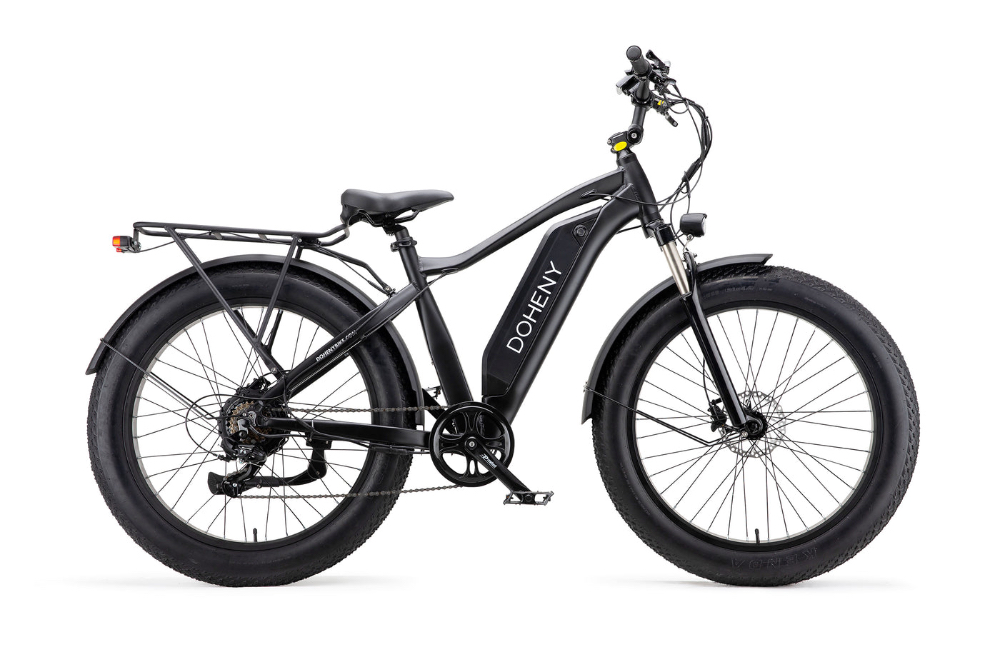Yesterday, I took my Doheny Fat Tire Cruiser out for an extended ride. I now have only 7 days left of the Doheny Bike return policy. My local area has either been too cold or had too much rain, so I haven’t been able to put the Cruiser through its paces. Yesterday, I rode for 23 miles, becoming comfortable with the bike’s controls, heft and speed.
First, let’s address my concerns after my previous short ride around the neighborhood:
- The issue with slack in the pedal assist system’s responsiveness is not an issue. It appears it was just my hesitation to pedal as forcefully, when the pedal assist accelerated the bike. Now that I’ve gotten used to the acceleration, as well as how to dampen its “eagerness” when I pedal, my pedaling style is more suited to an eBike. The result is that I did not experience any further slack in the pedals, during the longer ride.
- The noise I heard coming from the rear wheel has been localized. It was not being caused by the rear wheel hub motor or rear disc brake. It was the fender rubbing against the semi-knobby fat tires. The sound would come and go, based on wind direction and if I was making a turn. Upon further examination, it is easy to see that the fender is not centered over the tire. I suppose the fender, which was dented in transit to me, also had its supports bent a little. I cannot adjust this while the fender is on the bike, so I’ll take it off to bend the supports to their proper location and remount it. This will be a trial-and-error operation, since I won’t be able to judge how much I’ve moved the mount support until I mount it on the bike again.
Now, onto my observations from this ride:
First (for me, the most important): 5’6″ is absolutely the minimum height for a rider to be comfortable mounting the Cruiser. Once on the bike, I have no problem pedaling or straddling the center bar (on tip toes), but swinging my leg over the saddle is a challenge. This is especially true if I’m wearing bicycling shorts that have a gel seat. Mounting difficulty is exacerbated by my addition of a front frame bag, which allows me to take tools, eyeglasses and other stuff with me on a ride. (more on the bag I selected later)
Now, for performance:
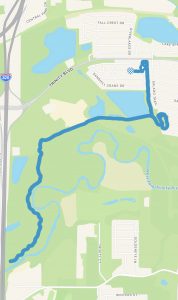
As I mentioned earlier, yesterday’s ride was 23 miles. The route I took is shown to the left. The recent rains prevented me from being able to ride ten miles out and back, as the area under Loop 820 is still flooded, so I rode the route 5 times to get to 23 miles, total. It took a few seconds over one hour to complete the ride, meaning my average speed was 23 miles per hour. I never got above pedal assist level 4 and was well into the ride before I dared try that. Level 4 is a lot of assist and the bike really moves at that setting. On my Trek human-powered bicycle (HPB?), when I was riding regularly, I could average around 14-15 miles per hour, so 23 mph was awesome (and a little scary in the turns). There were lots of leaves covering portions of the trails and, with the recent rains, I was concerned that they might be slippery and the bike could slip out from under me in a turn. Due to this, when I reached curves I
would normally push hard through on my Trek, I slowed down and took them carefully. Once the paved trails are clear of debris, I believe I will be comfortable enough to try them much faster. Inclines that would normally strain my knee joints and reduce my speed to 10 mph on my HPB were taken at 20 mph. This is an important point, especially for older riders or people with knee problems. I could exert pedal force without straining my knees and still get a decent workout! It was around 77º degrees F and I normally ride in 80 to 90 degree temps, so although it was cooler than my usual rides, I still worked up a good sweat. This is another benefit of eBikes I hadn’t anticipated. You can use this bike much later in your life than an HPB, due to the lack of knee strain. My purpose in riding has always been the workout, as opposed to recreation, with the goal of extending my life and my mobility. An eBike will help many seniors continue bicycling much later in life, hopefully achieving the goal of healthy, vigorous old age.
My last, short ride plus this one resulted in 25 miles on the bike so far but the battery charge status indicator had only dropped the second bar (out of five). I did not recharge the battery after my short ride. Newbies to electric vehicles may not realize that lithium-ion batteries do not have a “memory” like old NiCad batteries in cell phones used to have. In other words, you do not have to run the battery all the way down, before recharging. However, many eBike manufacturers suggest doing so occasionally will extend the battery’s life. If you’re not going to ride for an extended period (like in the winter) it is best not to store the battery fully charged or discharged. It’s best to keep it around 50% of charge, again to extend the battery’s life. Two bars down from from full, especially since the 2nd bar disappeared just before the ride ended, seems to indicate the 25 miles I’ve ridden represent about 40% of the battery’s range (if the decrease is linear). This would mean if I had a full battery, riding as I did today (pedal assist, levels 2-4) would result in about 62 miles of range! Holy cow!! My longest ride on my HPB was 60 miles and that occurred in a 100 km rally, back when I was 30 years old. My longest, recent ride on my HPB was 40 miles, in 90º heat and it was grueling.
Like electric cars, the bike uses regenerative braking, when you stop pedaling or pull on the brake levers. It is not forceful, so you don’t have to worry about losing control on slippery surfaces. As I adjusted to the Cruiser, I started using this feature more and more but was disappointed to see that the energy being regenerated does not appear on the bike’s display. It does show the rate at which energy is dispensed, just not regenerated. This is not a Doheny issue. I was told by an eBike manufacturer that none of them are building these bikes from scratch. They’re getting parts from various providers and assembling them into their branded product. That’s why so many of them look so similar. I saw a presentation, at the MOVE America conference in Austin, put on by a Bosch executive where this was mentioned. Her point was that some manufacturers may choose sub-standard components, like batteries, motors or battery management systems (BMS) that could be dangerous. Bosch offers a complete eBike power train that is UL certified, offering eBike manufacturers a way to be sure their eBikes are safe, especially when recharging. The lack of a regen readout is common on most eBikes.
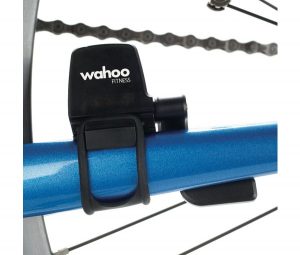
As my long-time readers know, I am a numbers guy. I like things to be quantifiable so I can monitor performance, both my vehicle’s and my own. Unfortunately, there is no “history” stored about the ride, no calculation of distance (for that one ride), cadence, average speed, route topology, heart rate/ranges, etc. Due to this, I bought an add-on that I have on my Trek HPB, the Wahoo Blue SC Speed and Cadence Sensor. This device, along with the accompanying app and my handy heart rate monitor, calculates all the data I need for my performance tracking. It utilizes a Hall effect sensor to access cadence and tire speed, so I need to make sure the Cruiser doesn’t have any other Hall effect sensor with which the Wahoo may interfere. I’ll let you know what I find out…
An issue I’ve had, even on my HPB is numbness in my fingers, during long rides. I am probably gripping the handlebar grips too hard, but I am also aware that the handlebar grips are pressing right against a blood vessel in my palms, causing my fingers, especially those in my left hand to go numb. I wear gel-padded bicycling gloves to reduce this, but it was very apparent on this ride. In fact, a couple times, I thought I had pressed the down button to reduce the pedal assist level, but in fact, failed to press hard enough for the change to take effect. This is a problem with my physiology, rather than the Cruiser, so if you know of a way to eliminate this issue, please place a comment at the end of this post.
I only have two complaints about the Cruiser. One is the lack of mounting lugs for a water bottle carrier (or two, like my Trek HPB has). It does have a rear rack, so I can bungee a bottle or two there, but I’d never be able to have a drink while riding. Our other eBike, a Rad Power RadCity 3 Step-Thru, has the lugs, but there’s also an optional water bottle holder that attaches to the handlebars. I can’t use this on the Cruiser, because I already have a wonderful mount for my GoPro camera, just like I have on my Trek. That’s how I shot the video of the short ride on the Cruiser that I wrote about earlier. The brand of mount I bought no longer shows up on Amazon, but this is exactly the same one, sold under a different brand name. This seems to happen on Amazon a lot, with Chinese products. I bought two originally and now have a use for the second one (on the Cruiser). Anyway, the Cruiser’s handlebars are now cluttered enough that I don’t have room to mount a water bottle holder on them.
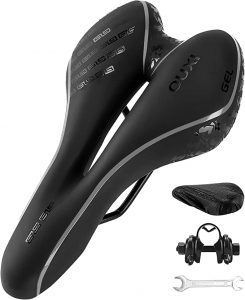
My other complaint is the seat. After such a long ride, I had some soreness in my coccyx (tailbone, for the uninitiated). I had the same issue with the saddle on my Trek and replaced that seat with one like this one. (Again, the brand I bought is no longer available on Amazon…)
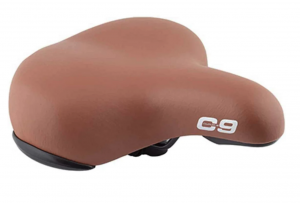
The seat for the cruiser is very wide and shaped like a farmer’s tractor seat. Doheny Bike offers an upgraded seat, called the “Cloud 9” for just $28 (on sale now for $22) that is supposed to be more comfortable. My quandary is: Do I want the “tractor” seat or one like I have that keeps away from my coccyx? It may not look right on a Cruiser, but what’s more important to me is comfort, as I expect my average ride will be 20+ miles, weather permitting.
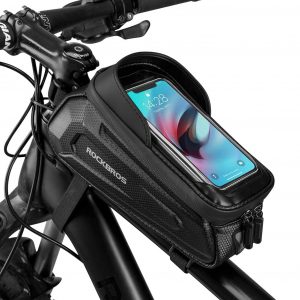
Remember my comment about a front frame bag making it difficult to mount the Cruiser? The bag I bought is from ROCKBROS. It is a water-proof, hard shell bag that holds onto the handlebar stem and horizontal frame member, via velcro straps. It not only holds items I need to take with me, but also has a place for my iPhone 13 Pro Max. It even has a port though which you can run a headphone cable, should you wish to have a wired headset. The iPhone rests behind a clear plastic screen that allows you to still access the touchscreen through the clear plastic or carry a secondary power source for your phone. The touchscreen access works great.
An iPhone as large as mine cannot be in a case, while in the bag, because it’s a snug fit in the ROCKBROS bag by itself. However, I feel it is protected enough by the bag and where it’s located on the bike, that I am not worried about the iPhone being damaged. My only complaints about the bag is it rolls to the left or right and it interferes with me mounting the bike, as I mentioned before. I will probably fix the rotation problem by placing some double-sided, weatherproof tape between the bag’s straps and the eBike’s frame to keep that from happening. I’ll live with the additional difficulty mounting the bike, as that has to do with my body size, rather than the bag. I like it’s functionality that much.
Now, back to the quandary I must resolve in the next 7 days: Do I like the Doheny Fat Tire Cruiser or do I want to return it? As of yesterday’s ride, I am very satisfied with the Cruiser, so I am definitely keeping it! A Doheny Bike rep told me they are discontinuing the Cruiser, to focus on eBikes that fold for easy transport. So if you’ve been thinking about an eBike and you’re 5’7″ or taller, they are on sale at $800 off the original price. They’re not building any more, so you’d better hurry!


